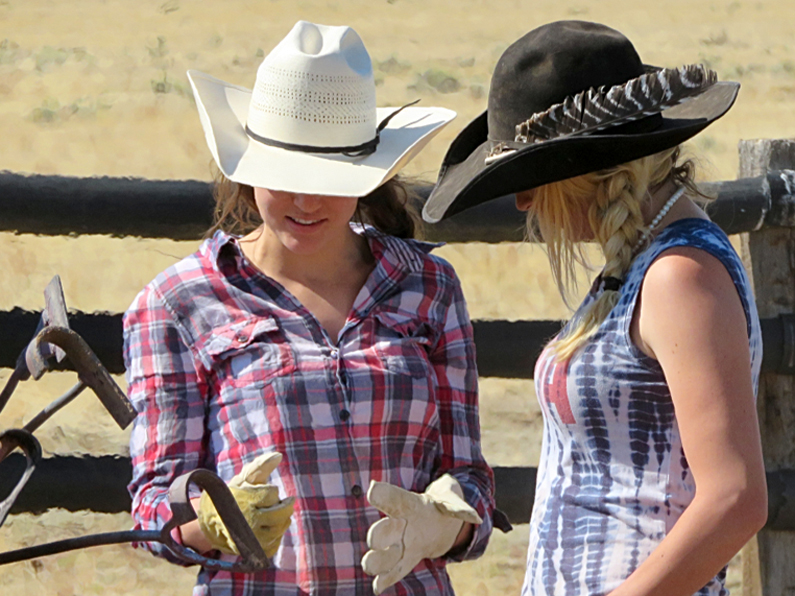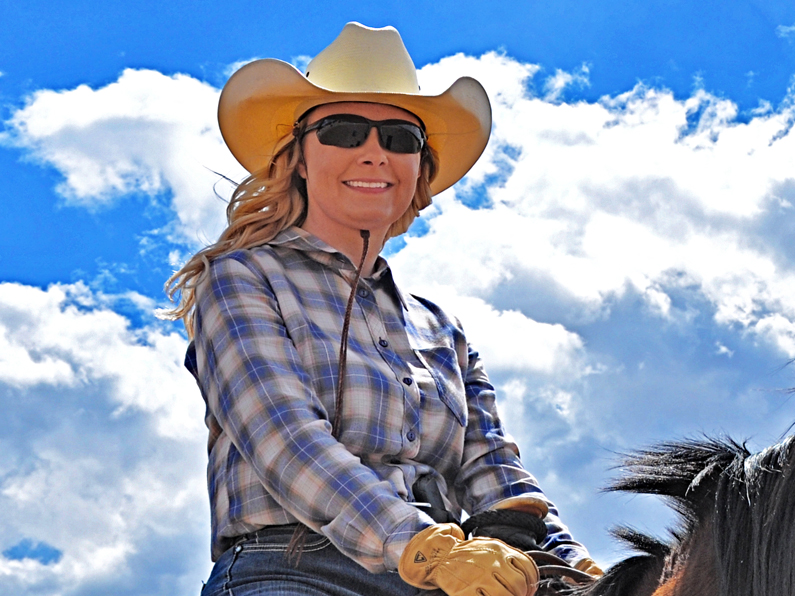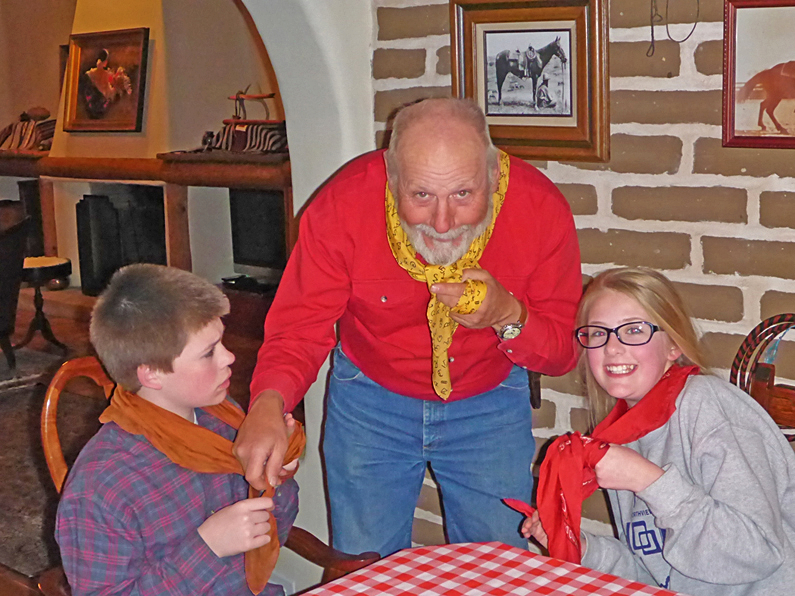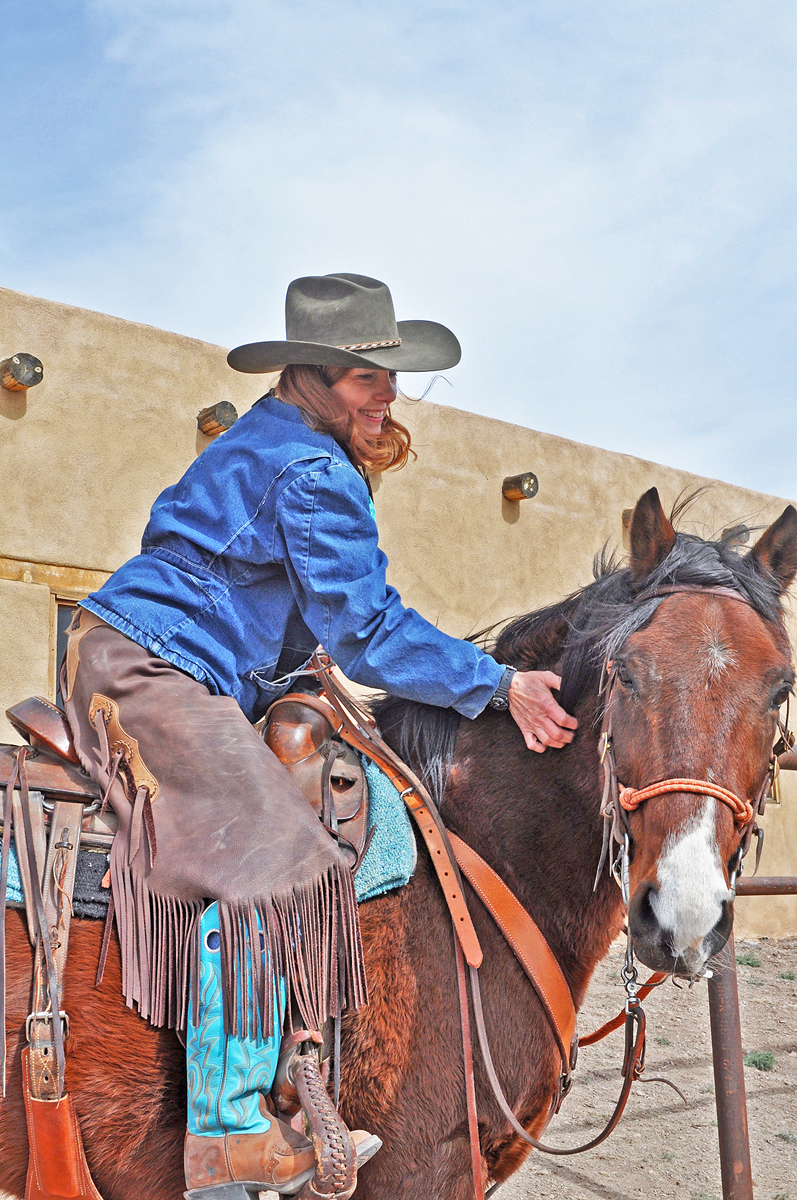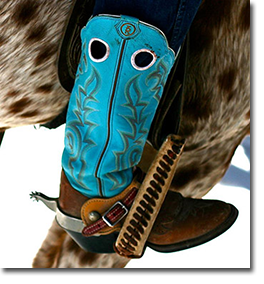Packin’ Your Bedroll (Things to Bring)
Guests often ask: “What clothing or gear should I bring to the ranch?”

Well, we call it “pack’n your bedroll.” Here are some suggestions for clothing and gear that can make your stay more enjoyable and, in some cases, safer.
Our guest’s desires to participate in activities vary. So keep in mind what you want to do while you are at Concho Hills Guest Ranch while your “pack’n your bedroll.” Tough clothes help protect us from the elements and “pointy things” from tumbleweed to barbed wire.
Let’s start with the way a cowboy dresses, from head to toe.
Cowboy Hat
First we recommend a broad brimmed hat, and nothing works better than a cowboy hat. At 7400 ft. elevation, the New Mexico Sun’s rays are bright and can be damaging to nose, ears, and neck. So providin’ shade to those parts is a great idea. Felt or straw, a good cowboy hat will protect your skin, in or out of the saddle. There is perhaps no other item of cowboy attire that is more telling than a man’s hat. Dyed-in-the-wool western folks can look at a cowboy hat and know instantly whether the wearer is a bull rider, rancher, buckaroo, or stockbroker. So if you ain’t use to wearing one, allow some time in pickin’ yours out. The maker will take a blank and customize it to your desires. That’s why they were invented and that’s why we wear’em.
Stampede String
A “stampede string” for the cowboy hat – to prevent the wind from sending your cowboy hat flying and to prevent your fellow riders from being entertained by you trying to “ride like the wind” to catch it. Some people dislike the strings but its worse having the ridin’ or working because someone has to chase a hat. They call it a stampede string because a flying hat can spook cattle or horses and cause a stampede. Occasionally, in New Mexico, the wind can be strong on the range. We wear’em.
Helmet
You will be given an option to ride with or without a helmet. Under certain conditions a helmet can protect your head from a concussion. Therefore, Concho Hills will provide basic helmets in small, medium, or large. However, if you typically ride in a helmet, we suggest you bring it along. Riders that choose not to wear a helmet, must sign a waiver.
Sunglasses:
Sunglasses are highly recommended. If you wear prescription lenses, then hopefully they will be of the “safety lens” variety. The sun is really bright here and sunglasses could save you hav’n the nick name “squint” if not prevent a headache from the glare. We always recommend wearing some kind of glasses, either sunglasses, your prescription glasses, or safety glasses. Rid’n behind a cantering horse (for those who choose to do so) can be a dusty and pelting experience from the small stones thrown from the hooves of the horse in front. We also ride through the trees where those limbs can get in your face. We will provide safety glasses to those who choose to use them.
Wild Rags:
Ever notice the cowboy’s neckerchief? A good silk neckerchief is most functional. It keeps the draft out in winter, or, when wet, it provides cooling in summer. It can prevent chafing, serve as a sling, tourniquet, bandage, ear warmer, dust filter, or eye shield for you or your horse. Did we mention the fashion statement? If you can’t find ’em, we will have a selection of wild rags in our gift shop.
Long Johns, (thermal underwear)
In winter, It can be chilly ~ but nothing like most folks from the north are used to. Here, we comfortably ride horses 12 months out of the year. That said, if you join us during our cold season, a set of long silky underwear or other warm undergarments are advised. Layers are most appropriate for our weather. But be sure your pants and shirts are large enough to accomodate what you wear underneath.
Cotton Shirts
We recommend a good strong shirt like a denim work shirt, or duck cotton. Nothing worse than seeing a grown person cry when their expensive and stylish shirt is snagged on a tree limb! Depending upon which activities you choose to participate, one may find it a little hard on the clothes. The environment is even harder on the skin so protect those arms from the tree limbs, insects, dirt, and sun.
Tough Jacket
A tough jacket like a jean jacket in summer, or a Carhartt-type coat in winter provides needed warmth and protection against the wind, dust, and elements. Most nylon shell-type coats and vest snag and rip easily.
Gloves
For break’n a fall, pulling wire, or break’n tree limbs nothing beats a good pair of leather gloves! Elk skin are the toughest and will last the longest and we have some in our gift shop. Yeah, there are some cowpokes with hands so tough they are like leather anyway. But the majority of us don’t have hands that can strip the bark off a pinion, so from pickin’ up manure to preventin’ burns and splinters those gloves are highly recommmended. You do have to hold your reigns, hence you’ll have to compromise between toughness and flexibility.
Jeans
A good pair of jeans or work pants, loose enough to swing that leg over your hoss but not so loose that the extra material bunches up between you and the saddle. For riding, if you ladies can find jeans without the bling (rhinestones) on the rear pockets, you may be more comfortable. Wrangler riding jeans or Levi jeans are the most popular working jeans, but the brand doesn’t matter. You may have to spend some time kneeling, so jeans with pre-formed holes in the knees are not a good idea. Out here, holes are “earned.”
Chaps (if you have ’em)
Riding through the trees, either for sightseeing or moving that calf, provides ample opportunity for a tree branch to poke and scrape those legs. For over a million years tumble weeds and cactus have left their spines and stickers across the land. We advise you to wear chaps (to the ankle) or chinks (to mid-calf), if you have ‘em.
Boots
For riding or being around the horses, boots are REQUIRED! A good western riding boot, or leather footwear, over the ankle, with smooth soles and a defined heel. Smooth soled boots help that foot slip out of the stirrup when needed, and at least a one-inch heel keeps the boot from slipping through the stirrup. A horse can step on your foot so you want to be protected. For safety, we cannot allow people to ride or be around horses in tennis shoes, flip flops, sandals or high traction (waffle stomper) soles. Fabric shoes are NOT acceptable. Rubber “muck” boots are not acceptable. Lace up or pull on boots are fine; and working Cowboy boots are perfect. Even when just walking around we recommend wearing boots or leather shoes. Boots will also protect your shins, ankles, and feet from cactus, thorns, seeds and other plants and critters!
If you choose, bring another pair of shoes for the evening.
Lip balm and Sunscreen
We’re not kidding about the sun and altitude. If you are not used to the altitude you’ll breath through your mouth a lot and sunburn is common. So it is a good idea to bring your favorite lip balm and sunscreen.
* If you’d like to enjoy a glass of wine, a beer, or cocktail, after you’ve finished riding for the day, please feel free to bring your favorite beverage. We don’t have a liquor license. The nearest place to purchase alcohol is at the Golden Spur Saloon in Magdalena. Questions? Please ask! Our goal is for everyone to have a wonderful experience without getting hurt.
Contact Us:
Still have questions or want to know more? Contact us and let us give ya a hand.

